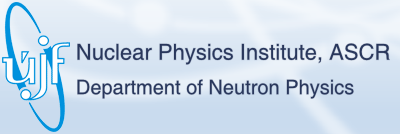Prompt Gamma Activation Analysis
The facility for the measurements of 10B concentrations in biological samples includes HPGe detector with 25% relative efficiency and associated Pb - 6Li2CO3 shielding. Described facility is installed at the distance of 1 m from the exit of the neutron guide. At the target position the neutron flux is approximately 3×106 n cm-2 s-1 at the reactor power of 8 MW. This facility makes it possible to determine 10B concentration of 1 ppm in 1 ml samples with statistical uncertainty of 5% within 15 min. This instrument is in a common property with Nuclear Research Institute, plc.
Applications:
The experimental set-up was mainly developed for the on-line determination of 10B concentrations of ppm-order in biological samples. This facility can also be used for determination of other isotopes with a sufficiently large (n,g) cross-section.
Instrument Parameters
| Neutron flux | 3·106 n/cm-2 s-1 | |
|
Beam cross section at target position
|
25 x 5 mm2 | |
|
Detector
|
HPGe (25% relative efficiency) | |
| Sample enclosure for liquid and powder sample |
Teflon cylinder vial : Diameter - 10mm & Height - 10mm |
Expected interference-free detection limit for PGAA instrument at research reactor LVR-15 assuming 24h irradiation.
| Element | Det. limit (µg) | Eγ (keV) | Element | Det. limit (µg) | Eγ (keV |
| Hydrogen | 20 | 2223 | Cobalt | 20 |
230, 556 |
| Boron | 0.06 | 478 | Nickel | 200 |
283, 465 |
| Nitrogen | 4000 | 1885, 5298 |
Copper | 10 |
159, 278 |
| Sodium | 70 | 472, 869 |
Zinc | 700 |
115, 1077 |
| Magnesium | 2000 | 585,1809 | Selenium | 40 |
239 |
| Aluminium | 500 | 1779, 7724 |
Molybdenum | 150 |
720, 778 |
| Phosphorus | 2000 | 637, 1072 | Silver |
30 | 192, 236 |
| Sulfur | 300 | 840, 2379 |
Cadmium | 0.1 |
559, 651 |
| Chlorine | 10 |
517, 786 |
Samarium | 0.03 |
333, 439 |
| Potassium | 100 |
770, 7771 |
Gadolinium | 0.02 |
182, 1186 |
| Calcium | 600 |
519, 1943 |
Gold | 30 |
215 |
| Titanium | 40 |
342, 1381 |
Mercury | 1.5 |
368 |
| Chromium | 150 |
749,834 | Lead | 40000 |
7368 |
| Manganese | 30 |
847, 1811 |
Neodymium | 10 |
619, 697 |
| Iron | 300 |
352, 7631 |
Indium | 5 |
162, 186 |
Application Example:
The deterimantion of boron concentration in graphene powder.




